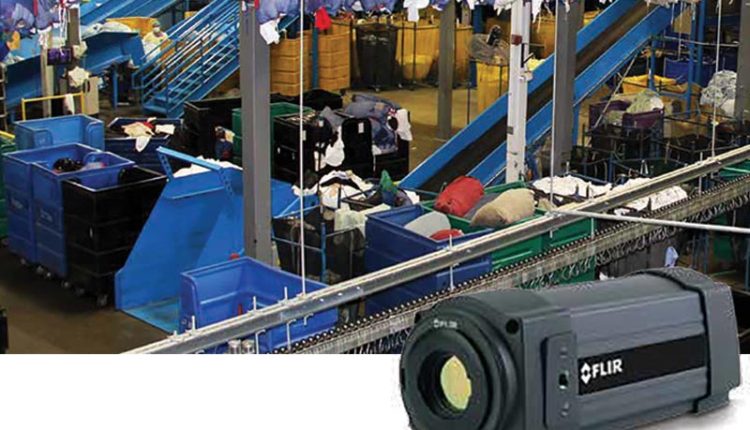Industrial laundry facilities rely on thermal imaging to ensure fire safety

Early warning fire detection system developed by MoviTHERM makes use of FLIR A310 cameras.
Large-scale laundry facilities face many fire risks. Combustible fabrics, the possible presence of flammable or reactive contaminants, and unmonitored or uncontrolled heating of laundry piles all increase the potential for spontaneous combustion. In order to prevent fires, FLIR integration partner MoviTHERM was asked to develop a thermal monitoring system that is able to spot heat build-up before a fire has the chance to spread. The innovative system includes advanced thermal automation cameras from FLIR.
Spontaneous combustion is a well-known problem at laundry facilities. The phenomenon depends on a number of conditions, including the availability of a fuel source, an oxidizing agent and a heat source.
How Laundry Fires are Starting
The linens themselves provide a readily available fuel source, especially when dealing with materials with high cotton content. Cotton materials begin to oxidize when surface temperatures reach 95°C. If the heat due to oxidization is not permitted to dissipate, the material may continue to heat until the point of ignition, resulting in a spontaneous fire.
Cotton laundry can often be contaminated with organic cooking oils that can self-ignite if dried and stored. When cleaning and petroleum products, or natural fats and oils are added to the mix, the potential for spontaneous combustion will increase.
It is not difficult to imagine how piles of soiled laundry left in the sun, or exposed to heat sources inside a laundry facility can become potential sites for spontaneous ignition, particularly if the soiled linens have been exposed to flammable or reactive substances. Due to the inherent risks, a multi-tiered fire prevention, detection, and response plan is needed.
Early Warning System
FLIR integration partner MoviTHERM (Irvine, CA, USA) was approached by an industry-leading linen and uniform supply company to design and deploy a thermal monitoring system. The intent of the monitoring system was to track the critical temperatures at key processing locations in their laundry facility, and generate warnings and alarms when temperatures exceeded expected limits.
The system was not designed to replace any existing fire detection and response protocols, because the customer did not wanted to rely on one system, or even one type of system. Rather, the system was designed to function as an early warning system – detecting areas in the facility where runaway oxidization and early ignition may be starting to occur. By providing advance warning earlier on pathway to ignition, costly, and potentially life-threatening fires can be averted before they are permitted to start and spread.
Flir Automation Cameras
To address the specific challenges, MoviTHERM adopted a distributed, multi-camera net work topology based on nine FLIR A310 came ras and three MIO-8 multichannel intelli gent I/O controllers.
The FLIR A310 cameras generate the thermal images used for the analysis. Specific regions of interest can be defined in each camera scene, so the early warning system can respond to unexpected temperature anomalies while at the same time, ignoring features that are expected to be out-of-range under normal operating conditions.
The digital output channels of the three MIO- 8 units are connected to industrial (audible) alarm annunciators and warning lights. These early-warning devices alert workers in the immediate proximity of the potential danger, enabling workers to start corrective action or evacuate to safety, depending on the severity of the risk.
Industrial auto-dialers are also integrated into the system, and configured for both a warning response and a critical alarm response. The lower-level alarm alerts plant managers by telephone when warning temperatures have been reached. The higher-level alarm automatically telephones dedicated fire response crews if critical temperatures have been detected.

System Set-Up
The nine FLIR A310 cameras are divided into three sub-groups. Each sub-group monitors a separate inspection zone inside the facility.
Zone 1 employs four cameras, and monitors the critical incoming loads. The incoming loads typically present the greatest fire risk, as the unprocessed laundry can contain a wide range of unknown contaminants. At this stage, unsorted linens can be susceptible to chemical reactions, which can result in spontaneous combustion.
The remaining 5 cameras are divided between Zones 2 and 3, which monitor areas in the facility where bags of partially processed laundry can remain stationary for extended periods. These are locations where oxidization monitoring can provide early warning of a potential hazard.

All of the camera images are routed to the monitoring station. A FLIR Network Video Recorder (NVR) records and archives the video streams, providing a live record of any event that might occur. When events occur – either warning or alarm events – the NVR is a useful tool for reviewing and investigating the event. Given the dynamic nature of an industrial laundry facility, a wide range of equipment and personnel can pass through the camera field-of-view on any given day. The archived video footage provides a useful way to determine whether events are false alarms, due to normal operational variability, or if they are legitimate alerts that require further action.
The live camera images are also displayed on a video monitor for continuous, real-time viewing by facility personnel.
The monitoring system functions as a stand- alone alarm system. It monitors, records, and alarms without any dependence on an external PC or PLC. The key component that enables this capability is the MoviTHERM MIO (Intelligent I/O) module. The three MIO units provide the discrete electrical connections needed to generate alarms and warnings based on predefined temperature conditions found in the camera images.

